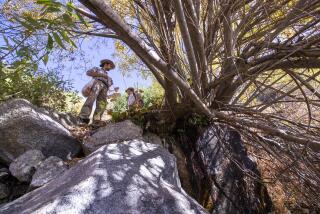Shhh. . . rare flower’s location is top secret
- Share via
MARYLAND'S EASTERN SHORE — Joe Fehrer, manager of Nassawango Creek Preserve, has set the rules: No photos of the horizon or any landscape feature that might identify this place. No naming the back road that leads here.
The cone of silence has nothing to do with nuclear codes or terrorist cells. The mission here is to protect a flower, an orchid, from would-be thieves.
Platanthera x canbyi, or Canby’s bog orchid, is a rare hybrid born of two rare parent orchids. This flower hasn’t been seen in Maryland in almost 20 years. And Fehrer would much rather that the rest of the world take it on faith that this fragile orchid has reappeared on the Eastern Shore.
To believe without seeing.
He would take a reporter to see it only reluctantly, he said, running the risk that the “orchid heads” would sneak out here and trample the delicate habitat. Or worse, haul out a garden trowel and steal the flower away to become a part some private collection rather than the start of a fledgling colony in the wild.
“They come here and search out rare orchids for their own gratification and remove them,” Fehrer said. “Some of these folks are real sleuths.”
Just past a clump of huckleberry bushes ripe with purple berries, Ron Wilson, a former high school science teacher turned professional botanist, held a bright yellow global positioning device close to his face, the better to read the plot points he recorded a few weeks ago when he discovered the hybrid.
“We’re lost?” Fehrer asked.
“It’s just I’ve got so many different overlapping plants,” Wilson said. “I’m having trouble reading them all.” He paused. “God, I might be stepping on it.”
Fehrer jumped onto a tree stump.
Despite cajoling by the Nature Conservancy, the preserve’s owner, Fehrer remained so conflicted about announcing Wilson’s find publicly that the orchid went out of flower while he tried to make up his mind. Finally he relented, on condition that the exact location be kept secret.
“We had an ongoing discussion,” Jon Schwedler of the conservancy said. “Everyone invoked the character out of the movie ‘Adaptation,’ the orchid thief.” (The 2002 movie, based on the book “The Orchid Thief,” told the story of one man’s obsession with finding the elusive ghost orchid.)
But in an era in which urbanized and video-game-obsessed children suffer “nature deficit disorder” and winning public support for preserving wild lands is a challenge, news of a mysterious rare orchid can be a boost for conservationists.
By the time Schwedler sent out a news release this month, however, the showy yellow flowers had withered and gone to seed. That made Fehrer happy, but now it is close to impossible to find the orchid in this 25-acre swath of boggy greenery.
“I think it’s somewhere over by this colicroot,” said Wilson, trudging, head down, his white knee socks pulled up over his khaki pants to prevent ticks and other insects from feasting on his legs.
The reason rare orchids and grasses are popping up all over this bog is fire. In May, the Nature Conservancy set the whole area ablaze. The controlled burn of what had once been a timber plantation of loblolly pines was designed to mimic the natural cycle of flood or fire that encroaching civilization has thrown out of kilter.
The burn created a wide, open, sunny habitat, bringing to life seeds that had been dormant in the soil for years.
Almost immediately after news of the find got out, Fehrer’s phone started ringing.
The orchid heads were on the hunt. They just wanted to see it, maybe take a picture. Please, could he just tell them the general area? Fehrer said he was busy, couldn’t help them.
What Fehrer does not know is that the orchid heads already have found this rare hybrid, blogging and obsessing about it on e-mail lists and in Internet chat rooms. They’ve even posted a photo that a local orchid head took on a surreptitious visit to the bog.
Paul Martin Brown, who has written books on some of the 268 species of orchids native to the United States, saw the picture online. “It was a beautiful individual,” he said. “If I wanted to go see it and no one would tell me where it was, it wouldn’t be that hard to figure out.”
In the hierarchy of orchids, Canby’s bog orchid isn’t all that special. Not like the rarely seen ghost orchid or any number of the 35,000 tropical orchid species that can live in only one very specific place, growing in one particular fungus and sometimes pollinated by only one insect on Earth.
What got orchid heads buzzing was that the hybrid was found in Maryland, where it hadn’t been seen in decades.
As Wilson continued on the hunt, the sky began to cloud over. Sweat broke through his gray T-shirt as he squatted close to the ground in search of the plant. Suddenly, he stopped.
“Oh my God!” He leaned down and peeked at two thin, unremarkable green stalks with a single slender leaf, no more than about 8 inches high. A deer had most likely come along and chomped the flower and most of the rest of the rare Canby’s bog orchid for lunch.
“If I found this today, I wouldn’t know it’s the hybrid,” Wilson said, shaking his head. “I’d probably have to do DNA analysis.”
Fehrer leaned back on his heels and smiled. His secret was safe.
More to Read
Sign up for Essential California
The most important California stories and recommendations in your inbox every morning.
You may occasionally receive promotional content from the Los Angeles Times.










